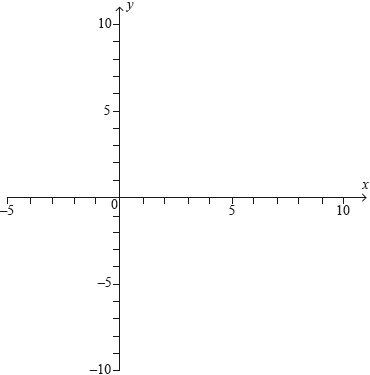| Date | May 2022 | Marks available | 4 | Reference code | 22M.2.AHL.TZ2.6 |
| Level | Additional Higher Level | Paper | Paper 2 | Time zone | Time zone 2 |
| Command term | Determine | Question number | 6 | Adapted from | N/A |
Question
At an archery tournament, a particular competition sees a ball launched into the air while an archer attempts to hit it with an arrow.
The path of the ball is modelled by the equation
where is the horizontal displacement from the archer and is the vertical displacement from the ground, both measured in metres, and is the time, in seconds, since the ball was launched.
- is the horizontal component of the initial velocity
- is the vertical component of the initial velocity.
In this question both the ball and the arrow are modelled as single points. The ball is launched with an initial velocity such that and .
An archer releases an arrow from the point . The arrow is modelled as travelling in a straight line, in the same plane as the ball, with speed and an angle of elevation of .
Find the initial speed of the ball.
Find the angle of elevation of the ball as it is launched.
Find the maximum height reached by the ball.
Assuming that the ground is horizontal and the ball is not hit by the arrow, find the coordinate of the point where the ball lands.
For the path of the ball, find an expression for in terms of .
Determine the two positions where the path of the arrow intersects the path of the ball.
Determine the time when the arrow should be released to hit the ball before the ball reaches its maximum height.
Markscheme
(M1)
A1
[2 marks]
(M1)
OR ( OR ) A1
Note: Accept or from use of .
[2 marks]
(M1)
Note: The M1 might be implied by a correct graph or use of the correct equation.
METHOD 1 – graphical Method
sketch graph (M1)
Note: The M1 might be implied by correct graph or correct maximum (eg ).
max occurs when A1
METHOD 2 – calculus
differentiating and equating to zero (M1)
A1
METHOD 3 – symmetry
line of symmetry is (M1)
A1
[3 marks]
attempt to solve (M1)
(or ) (A1)
A1
Note: Do not award the final A1 if is also seen.
[3 marks]
METHOD 1
M1A1
A1
METHOD 2
A1
when so M1A1
METHOD 3
if
M1A1
solving simultaneously, A1
()
METHOD 4
use quadratic regression on M1A1
A1
Note: Question asks for expression; condone omission of "".
[3 marks]
trajectory of arrow is (A1)
intersecting and their answer to (d) (M1)
A1
A1
[4 marks]
when (A1)
attempt to find the distance from point of release to intersection (M1)
time for arrow to get there is (A1)
so the arrow should be released when
A1
[4 marks]
Examiners report
This question was found to be the most difficult on the paper. There were a good number of good solutions to parts (a) and part (b), frequently with answers just written down with no working. Part (c) caused some difficulties with confusing variables. The most significant difficulties started with part (d) and became greater to the end of the question. Few candidates were able to work through the final two parts.


